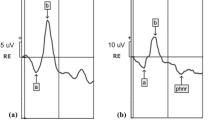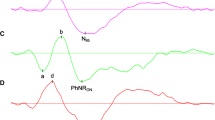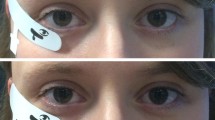Abstract
Steady-state (8 Hz) pattern electroretinograms in response to sinusoidal gratings were recorded from 18 elder subjects (mean age 62.7 years) and 22 young subjects (mean age 27 years) by means of skin electrodes. All subjects were free from ocular pathology and their corrected visual acuity was 1.0 or better. In young subjects the second harmonic amplitude as a function of spatial frequency is spatially tuned, with a maximum at around 1.7 c/deg. The response of elder subjects is significantly (P < 0.05) reduced over the whole range of spatial frequency as compared with that of younger ones. This decrease is more marked (P < 0.01) at intermediate spatial frequencies, resulting in a shallower tuning. The response phase is not significantly different between young and elder subjects.
Similar content being viewed by others
References
Maffei L, Fiorentini A. Generator sources of the pattern ERG in man and animals. In: Cracco RQ, Bodis-Wollner I, eds. Frontiers of clinical neuroscience, Vol III. New York: Alan R Liss, 1986; 101–6.
Porciatti V, von Berger GP. Pattern electroretinogram and visual evomed potential in optic nerve disease: early diagnosis and prognosis. Doc Ophthalmol Proc Series 1984; 40: 117–26.
Plant GT, Hess RF, Thomas SJ. The pattern evoked electroretinogram in optic neuritis. Brain 1986; 109: 469–90.
Porciatti V, Falsini B, Brunori S, Colotto A, Moretti G. Pattern electroretinogram as a function of spatial frequency in ocular hypertension and early glaucoma. Doc Ophthalmol 1987; 65: 349–55.
Fiorentini A, Maffei L, Pirchio M, Spinelli D, Porciatti V. The ERG in response to alternating gratings in patients with diseases of the peripheral visual pathway. Invest Ophthalmol Vis Sci 1981; 21: 490–3.
Owsley C, Sekuler R, Siemsen D. Contrast sensitivity throughout adulthood. Vision Res 1983; 23: 689–99.
Hess RF, Baker CL Jr. The human pattern-evoked electroretinogram. J Neurophysiol 1984; 51: 939–51.
Porciatti V. Nonlinearities in the focal ERG evoked by pattern and uniform-field stimulation: their variation in retinal and optic nerve dysfunction. Invest Ophthalmol Vis Sci 1987; 28: 1306–13.
Weleber RG. The effect of age on human cone and rod ganzfeld electroretinogram. Invest Ophthalmol Vis Sci 1981; 20: 392–9.
Arden GB, Carter RM, MacFarlan A. Pattern and Ganzfeld electroretinograms in macular disease. Brit J Ophthalmol 1984; 68: 878–84.
Odom JV, Maida TM, Dawson WW. Pattern-evoked retinal responses (PEER) in human: Effects of spatial frequency, luminance and defocus. Curr Eye Res 1982; 2: 99–108.
Odom JV, Norcia AM. Retinal and cortical potentials. Spatial and temporal characteristics. Doc Ophthalmol Proc Series 1984; 40: 29–35.
Wheale RA. Retinal senescence. Retinal Research 1986; 5: 53–79.
Author information
Authors and Affiliations
Rights and permissions
About this article
Cite this article
Porciatti, V., Falsini, B., Scalia, G. et al. The pattern electroretinogram by skin electrodes: Effect of spatial frequency and age. Doc Ophthalmol 70, 117–122 (1988). https://doi.org/10.1007/BF00154742
Issue Date:
DOI: https://doi.org/10.1007/BF00154742




